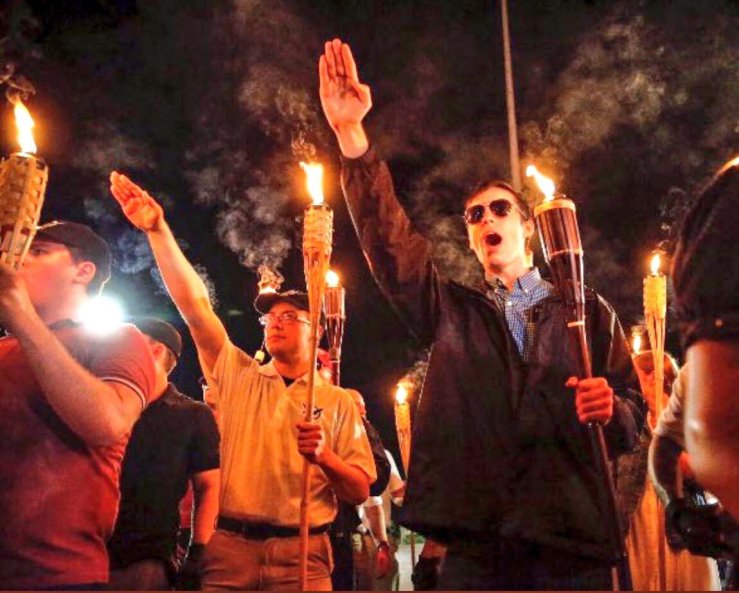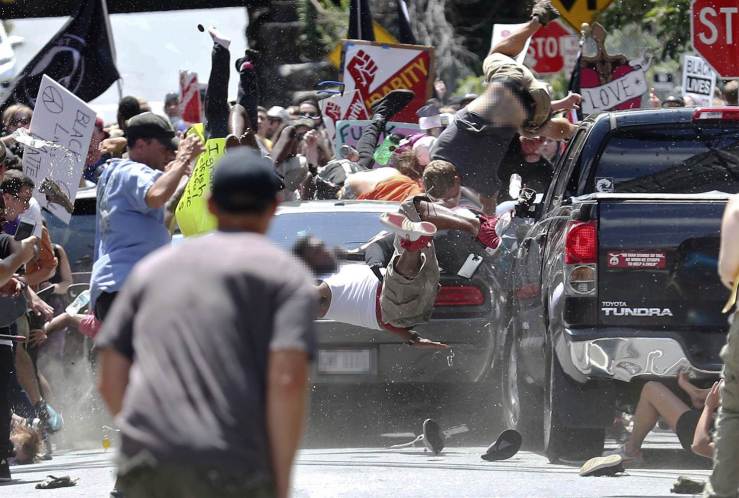If you haven’t heard the news of what’s happened in the small college town of Charlottesville, Virginia over the last 24 hours, let me give you an update: following the city’s decision to remove Confederate iconography from public property, far-right activists and members of the Ku Klux Klan converged on the University of Virginia’s campus last night, chanting things like, “Blood and soil,” and, “You will not replace us,” in an attempt to supposedly, “start standing up for [their] history.” The rally was condemned by many city officials (and University of Virginia officials) as a “cowardly parade of hatred, bigotry, racism, and intolerance.” A state of emergency was declared by the governor of Virginia after fighting broke out with counter-protesters, and this afternoon, a speeding car rammed into a group of counter-protesters, injuring at least 19, and leaving one person dead. Following this, Donald Trump told reporters: “We are closely following the terrible events unfolding in Charlottesville, Virginia. We condemn in the strongest possible terms this egregious display of hatred, bigotry and violence on many sides, on many sides.”
You can read more at: http://www.cnn.com/2017/08/12/us/charlottesville-white-nationalists-rally/index.html
The news is still rolling in, but let’s get one thing straight. When a white nationalist runs a car into a group of counter-protesters, it is not about hate “on many sides.” It is, however, an excellent example of the kind of acts that white supremacists have engaged in to silence, terrorize, and kill people of color in this country for centuries. Or, in other, more accurate terms: terrorism. The false equivalence by Trump of this notion of “many sides” is just another distraction from his refusal to condemn white supremacy — and yet another example of the kind of rhetoric that has emboldened such people within this country in the last few years. Make no mistake — we were never living in a post-racial society, but the kind of racist and hateful rhetoric peddled by Trump and his supporters is exactly what has given way to such violence.
This is not an issue of free speech. This is an issue of hate speech, and a continued refusal from moderates and the right to call these white nationalists exactly what they are: Nazis. If it talks like a Nazi, salutes like a Nazi, kills like a Nazi — well, I don’t think it’s exactly out of line to call a thing what it is.


Take a look at the images above. Nazi salutes. Cars driven into those who dare to stand against hateful words and actions. These are not long-dead images of the past — they are images of a hateful present, where racism, xenophobia, hatred, and bigotry are not only alive and well — they’re flourishing.
To my fellow white people: we cannot stand idly by while white supremacists terrorize and murder people of color. We must denounce acts of racism, no matter how big or how small. Call out your friends, your family, your neighbors — ruin Thanksgiving if you have to. We cannot let hateful, intolerant, or ignorant words slide, because the images you see above? These are what they become. There is no “not taking a side” on issues like this. To refuse to stand against oppression is to accept it, and to accept it is to encourage it. Remember seeing images of a hateful past in history class and thinking to yourself, “If I were alive back then, I would have done something”? You are alive right now. The fight is right now. This is your time to do something.
So do something.

